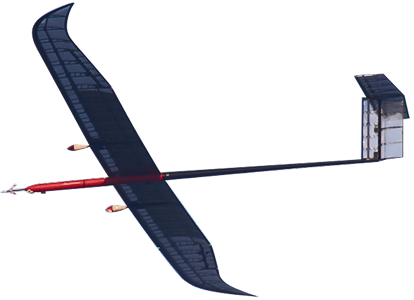



Stratospheric solar-powered UAVs are gaining international attention as long-endurance electric aircraft capable of operating for several months at altitudes over 18 km. These platforms combine eco-friendly electric propulsion systems with high-altitude, long-endurance (HALE) technologies.
These UAVs take off using batteries and rely on solar cells mounted on the upper wing surfaces to continuously recharge the batteries during flight, enabling long-duration missions in the high-altitude stratosphere.
At 18 km altitude, atmospheric pressure is only one-fourteenth of that at sea level, and temperatures can drop to –70°C. However, stable atmospheric conditions—free from clouds and precipitation—allow for continuous solar power during daytime, making these UAVs ideal for missions such as Earth observation, weather monitoring, and communication relay. Flying at 18 km—well above the typical 10 km cruising altitude of commercial airliners—dramatically reduces the risk of mid-air collisions, ensuring safe and uninterrupted UAV operations.
According to a report by the Teal Group, a leading U.S. aerospace market research firm, the market for high-altitude, long-endurance UAVs in the communications sector is expected to grow to USD 1.5 billion by 2025—surpassing the agricultural UAV market (USD 1.36 billion) and approaching the construction sector (USD 1.65 billion).
KARI conducted flight tests with EAV-1, a 2.6-meter wingspan aircraft powered by a fuel cell system. Subsequently, the 6-meter wingspan EAV-2 was developed to evaluate the advantages and limitations of different power sources. While EAV-1 could fly for only 1.5 hours using conventional batteries, it successfully flew for 4.5 hours in 2010 using a PEM-type fuel cell with low-pressure hydrogen generation. In 2012, the hybrid EAV-2, which used fuel cells and batteries at night and solar energy during the day, achieved a continuous 22-hour flight.
The extended version, EAV-2H, set a Korean record with a 25-hour and 40-minute continuous flight in 2013. In 2014, it reached an altitude of 10 km, establishing a national altitude record for unmanned aerial vehicles.
KARI then developed the EAV-3, a 20-meter wingspan UAV powered solely by solar cells and batteries, simplifying the power system. In 2015, it reached an altitude of 14.2 km, and in 2016, and flew for 90 minutes at 18.5 km in uncontrolled airspace, demonstrating the potential for stratospheric solar-powered UAV operations. This achievement placed Korea third in the world, following the United States and the United Kingdom.
Since then, KARI has developed high-performance battery packs and ultra-lightweight, high-strength structures capable of stratospheric flight. The communication system was also enhanced to transmit real-time HD imagery up to 50 km away. In 2020, KARI set a new national endurance record with a 53-hour continuous flight, including a 16-hour mission at altitudes ranging from 12 km to 18 km. In the same year, a UAV powered by a domestically produced lithium-sulfur battery reached an altitude of 22 km, marking the highest flight for any unmanned system in Korea.
Operating in the stratosphere, where air density and temperatures are extremely low, requires advanced technologies, such as ultra-light airframe structures, low-temperature and low-density propulsion systems, solar and battery power systems, low-Reynolds-number propeller design, and robust autonomous flight control systems.
To address these needs, KARI introduced the T-800-class domestic composite materials into UAV construction for the first time and applied Mylar fabric, known for its low-temperature resilience and tensile strength. Additionally, low-speed, high-torque BLDC motors and corresponding controllers were developed to operate in –70°C environments.
High-efficiency propellers optimized for low Reynolds number conditions were designed to match motor characteristics and the low-density stratospheric environment. Major systems, including the flight control computer, atmospheric sensors, and control surface actuators, were all dual-redundant to ensure safe, autonomous operation in emergency situations.
Building on past research achievements, KARI is currently developing EAV-4, a world-class stratospheric solar-powered UAV capable of carrying over 20 kg of mission payload and maintaining continuous flight in the stratosphere for over 30 days. A full-scale flight test is planned for 2025 to validate its performance under real stratospheric conditions. Starting in 2026, KARI aims to develop this system as a demonstration platform to support future public mission demands.